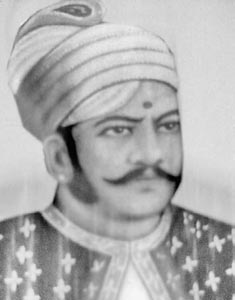Velu Tampi Dalawa – Martyr of freedom

Source:www.newindpress.com
Author: S T Suresh Kumar
On March 28, 1809, the lamps in Mannady temple turned dim. Velu Tampi knew his life was coming to an end. His helpless brother was witness to the bold act of this son of Travancore.
Hours before the British soldiers and the traitor Dewan Ummini Tampi reached the temple, Velu Tampi had already attained martyrdom. He sacrificed his life for freedom. Tampi’s fate was decided when he handed over his sword to the Rajah of Kilimanoor. (The sword of Velu Tampi kept in the National Museum, New Delhi, was missing for 50 years. After constant efforts by eminent historian Prof T P Sankaran Kutty Nair, the museum authorities have located the sword now.)
The bicentennial of the martyrdom of Chempakaraman Velayudhan is relevant today. Velu Tampi’s self slaughter can never be considered an act of cowardice. Prof Sankaran Kutty Nair says, “Velu Tampi knew pretty well that the nattukoottams and the local soldiers, the Nairs and Theeyas whom he organised from the Kundara region and those downtrodden Dalits who supported him whole-heartedly would never match the British army. When he was surrounded, he had no go but to kill himself to avoid being captured alive by the Englishâ€.
Velu Tampi’s martyrdom shows his daring spirit of freedom and love for the country. He could have saved himself even before the revolt if he had accepted the free and safe passage to Chingalpet offered by Colonel Colin Macaulay, the Resident of Travancore. Velu Thampi was appointed Dalawa in 1801 by King Bala Rama Varma. The British subsidiary forces took charge of the military affairs of Travancore through the treaty of 1805. Velu Tampi and the natives of Travancore became the enemies of the English East India Company resulting in the outbreak of the revolt. But Prof Sankaran Kutty Nair says, “The treaty of 1805 was not a reason for the final revolt of 1808-09. Velu Thampi wanted to get rid of the Britisth empire with the support of the French. He even contacted the Zamorin of Calicut for help, but the Zamorin informed the English about it giving them sufficient time to prepare for war.
In modern comparisons, Velu Tampi is a true nationalist; perhaps one of the earliest of the sub-nationalistic fighters of freedom.â€
The native enemies of Velu Tampi along with the ousted corrupt officials helped the British. Thus it was very easy for the British to defeat a demoralised and ill-equipped native force. But the situation could have been entirely a different one if the native forces had resorted to guerilla warfare as pointed out by Fuller C J. Velu Tampi’s harsh methods of punishment against criminals and corrupt officials sound cruel and crude when compared with our liberal ways of punishment.
But his commitment to justice and love for freedom are indisputable. The revolt of 1808-09 gifted our motherland with the martyrdom of Velu Tampi and innumerable common people. Many historians consider Velu Tampi’s Kundara Proclamation on 14 January 1809 as the Magna Carta of India’s freedom. Prof T P Sankaran Kutty Nair observes, “There is nothing about any type of religious bias or personal bias in the Kundara Proclamation. It was the real charter of the Indian Liberties against British colonialism and imperialismâ€.
Â
Welcome to Haindava Keralam! Register for Free or Login as a privileged HK member to enjoy auto-approval of your comments and to receive periodic updates.
Latest Articles from Dharma Smriti
- In memory of Dr N Gopalakrishnan
- Treading the Middle-Path on Temple Management
- ആദി ശങ്കര ജയന്തി – പ്രഭാഷണം
- അമേരിക്കന് പ്രൊഫസര് ജോണ് ഗ്രൈംസിന് ഭഗവാന് ഗണേശന് കൊടുത്ത ദിവ്യാനുഭവം
- Forgotten Temples Of Malappuram – Part I (Nalambalam of Ramapuram)
- Holy Karkidakam – Ramayana to Echo from Haindava Homes
- Poonthanam’s complete works translated into English
- Pamba Aarati – Dispell the Engulfing Darkness
- Milords! What the judiciary must know before any final verdict on Sabarimala
- Swami Chidanandapuri on Sabarimala


Responses